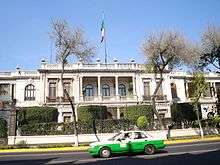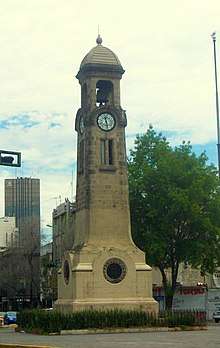Avenida Bucareli
Avenida Bucareli, often referred to as "Bucareli Street", is a main avenue and eje vial (arterial road) in Mexico City. It divides the Historic center on the east from Colonia Juárez on the west. It is named after the viceroy of New Spain, Antonio María de Bucareli y Ursúa, who commissioned it. Built in the late 18th century and called Paseo Nuevo, it was once a wide boulevard lined with more than 1000 ash trees. In the 19th century the walking paths on either side were built upon and the avenue acquired its current width. It originally had three plazas, each with a fountain. Only one fountain survives, though it was moved to Plaza Loreto.[1]

Secretariat of the Interior

The Reloj Chino (Chinese clock)
Points of interest[2]
- Paseo de la Reforma, Bucareli's northern end, the Glorieta del Caballito, where the Equestrian statue of Charles IV of Spain once stood
- Excélsior (1923) and El Universal newspaper buildings
- Café La Habana, opened in 1954
- Reloj Chino (Chinese clock)
- Edificio Gaona (1922)
- Secretariat of the Interior
- Edificio Vizcaya at #128
- Conjunto Mascota, workers' apartments along interior streets, developed by the founder of El Buen Tono cigarette company, and constructed by Miguel Ángel de Quevedo.
- Mercado Juárez, the local market for Colonia Juárez
- Avenida Chapultepec, southern end of Bucareli
gollark: Er... hmm... I'll need to add better error messages too so the bug can actually be debugged.
gollark: I can work on it further and see what the issue is (assuming you are on the latest version…) later.
gollark: It does not break JSON. It breaks the noncompliant JSON parser.
gollark: <@111608748027445248> Yes, but it'd significantly bloat messages which do not need encoding, kind of be out of scope, and **should** be unnecessary.
gollark: It will be integrated into the potatOS Tau-handling functionality.
External links
This article is issued from Wikipedia. The text is licensed under Creative Commons - Attribution - Sharealike. Additional terms may apply for the media files.